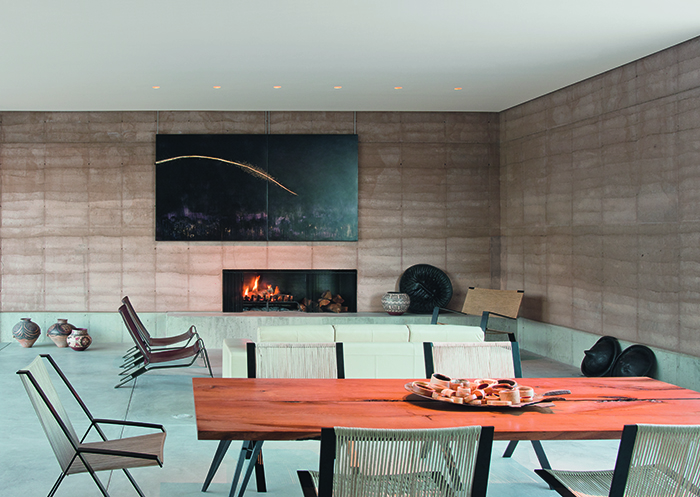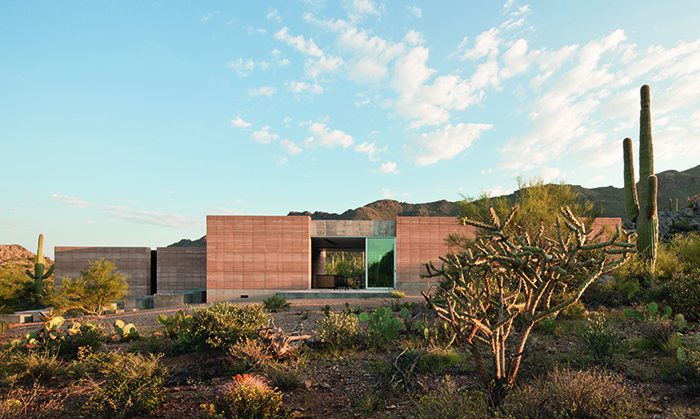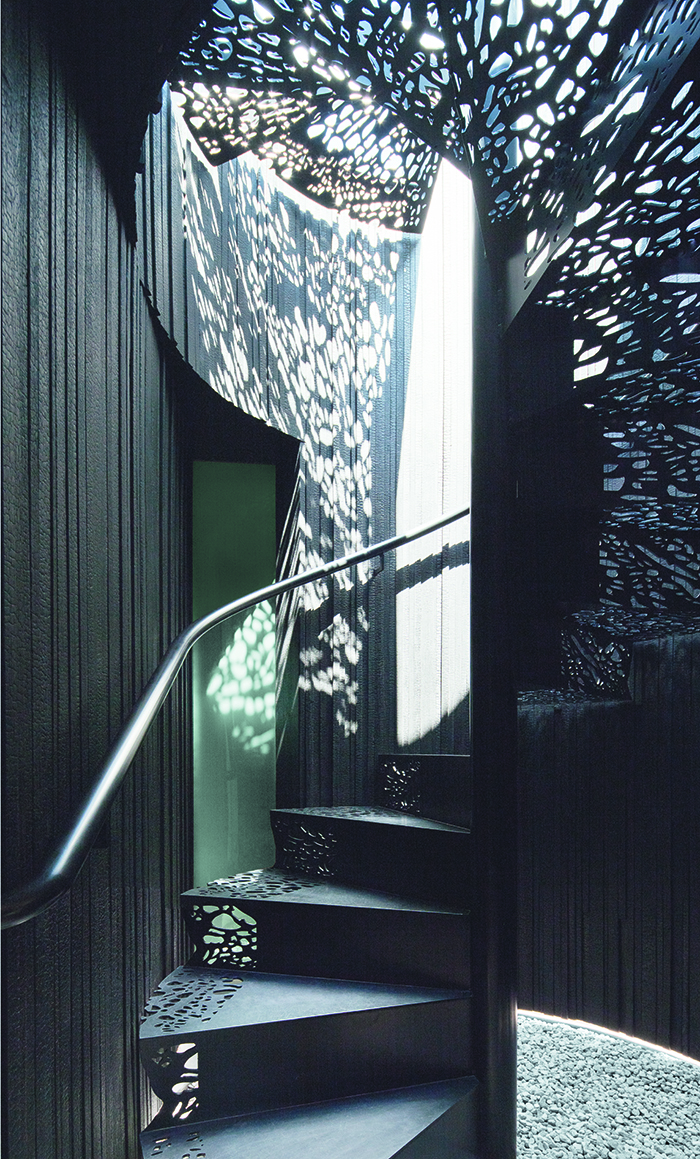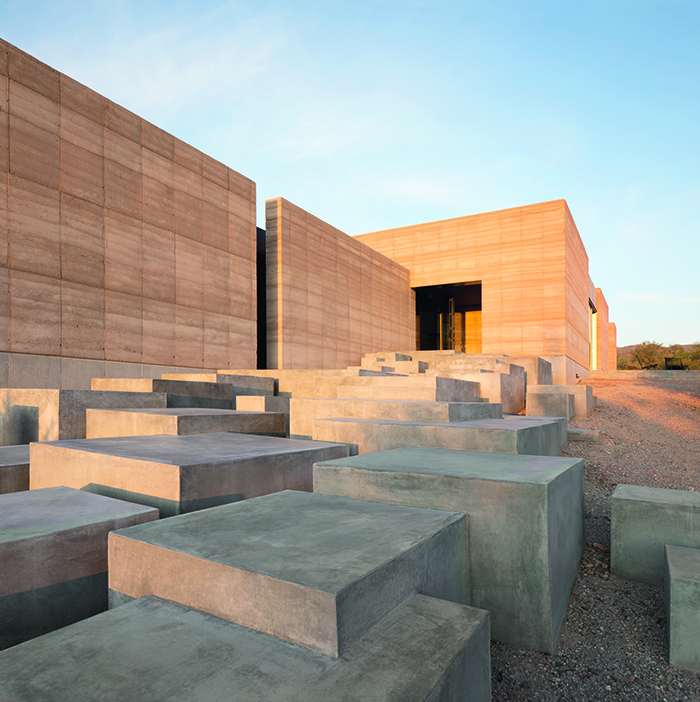With its exterior of local raw materials and its architectural openness, this retreat sits neatly in its desert surrounds.
Abutting the pristine Saguaro National Park within the Sonoran Desert in Tucson, Arizona, stands a stretch of rammed-earth walls that blends seamlessly with the arid landscape of dusty cacti and dry red dirt surrounding it.
The original site was suited to a home that would enhance the beauty of its desert location while remaining empathetic to its natural environment. The result: a haven free from the restriction of sealed-off living quarters, constructed from a palette of materials sourced from the surrounding area.
"The home is primarily made of rammed earth, a material that uses widely available soil, provides desirable thermal mass, and has virtually no adverse environmental side effects," says DUST architect Cade Manning Hayes. "The initial decision to use rammed earth to build the project informed the entire process, and contributes to the integration of the home into the landscape."

The chairs and tables in this dining room setting were created by Cade Hayes and Jesus Robles, the architects behind the project. With an emphasis on engaging the senses and evoking a strong connection with the desert, the architects designed the furniture to use raw materials, which were employed in the construction by master craftsmen in Tuscon.
Cade says the home is carefully positioned to make the best of adjacent arroyos, ancient cacti, animal migration paths, air movement, sun exposure and views.
"With the parking intentionally isolated more than 400ft (122m) from the house, one must traverse and engage the desert by walking along a narrow footpath toward the house," he says. "The arrival is marked by a sequence of fractal concrete cubes that ascend toward two entries; midway up the steps, a narrow slit marks the bedroom entry, while a dark square void defines the main entry. Rammed earth walls weave through the plan, dissecting it into three zones and enclosing spaces on three sides as they imprint the home with a warm texture."

Large glass doors feature on opposite sides of the living area, allowing for a seamless transition between home and the great outdoors.
Living, sleeping and home entertainment make up the main areas. "Each zone
must be accessed by leaving the occupied zone, stepping outside, and entering
a different space," Cade explains.
"This separation resolves the clients' desired acoustic separation while at the same time offering a unique opportunity to continuously experience the raw desert landscape."
The living space – the only room open to both the north and south facades – is the heart of the house and acts as a barrier separating the music studio from the bedrooms.
"The smell of Spanish cedar permeates the bedrooms as the charred walls that clad the bathroom core invite touch, and evoke visual references of a drought-ridden desert floor," says Cade. "Further reinforcement of the permeability in
the design is discovered as dappled light filters beneath a spiral stair that
leads towards a panoramic stargazing roof deck."

A staircase, custom-made by design studio PI.KL and aptly named Serpent, allows dappled light to filter into the home. The stairs lead up towards a panoramic star-gazing roof deck overlooking the desertscape.
Maintaining its ecological integrity, the home has a generous rainwater harvesting system with an advanced filtration system. Along with these sustainable elements, DUST also made the most of the materials, furniture and decoration within the home, injecting personality into the final design.
The architect says the home was designed to fulfil the client's dream of reconnecting with his roots, which lie buried in the Sonoran Desert.
"This private residence is defined by a desire to share, rather than simply exploit the gifts of the unspoiled location, with a focus to allow the constantly changing desert light, and the backdrop of the living desert landscape to holistically inhabit the spaces, and be integral to the life experiences in the home."

A sequence of fractal concrete cubes ascends towards two openings. Midway up the steps, a narrow slit marks the bedroom access, while a dark, square void defines the main entry.
.jpg)
Inspired by the desert surrounding the home, the interior is made up of a combination of charred walls, Spanish cedar and concrete flooring. Extra highlights include white onyx and soapstone countertops, plus Shou Sugi Ban feature panelling.
A great amount of effort was invested to minimise the home's overall impact on the awe-inspiring, mystical landscape.
"The reduction of spaces to their bare essence opens the potential for the architecture to fade to the background of life, thus becoming an empty canvas,
a simple vessel for human occupation and interaction," Cade says. "When the large glass panels are fully opened, the residence evokes a boundless Ramada-like spirit, animated by ever-changing desert, its light and scent."
 DESIGN FILE
DESIGN FILE
Cade Hayes from DUST reflects on the significance of environmentally friendly features in the retention of an unspoiled land.
How does this home connect with the outdoors?
The plan and openings allow the user to experience a connection with the exterior landscape: the diorama-like apertures open up to watch light and animals; the feeling as you move through the spaces – weaving inside and outside through one zone to the next – is like you are part of the desert. You wake up with the colours of the sunrise. The light is always changing, inside and out. When you see the sunset, the landscape takes on the colours of the sky.
Were there any obstacles during the design?
The fragility of the desert landscape – the desire to protect and preserve and respect the flora and fauna of the site – locked us into a small, controlled building area.
How does this home demonstrate sustainability?
Minimising door and window openings in the narrow east and west facades reduces solar heat gain; deep overhangs direct cross-ventilating breezes into the spaces, provide shelter from the summer sun, and capture the winter light for passive heating. The home also has a generous 30,000-gallon rainwater harvesting system.
What key features did you use for the build?
Shou Sugi Ban (or Yakisugi): the traditional art of charred cedar. It's an ancient Japanese exterior siding technique that preserves wood by charring it.
What is your favourite feature of the home?
All of it: small details, handmade handles and doors, the Shou Sugi Ban, the entry, the spiral stairway; it's hard to choose – it's like choosing a favourite food, or colour.
Contacts
DUST dustdb.com (architecture, interior design and custom furnishings)
Carson Concrete carsonconcrete.com (concrete)
Claudia Kappl claudiakappl.com (lighting)
Davinci Designs davincidesigns.org (cabinets)
Jim Waid jimwaidart.com (art)
Mayme Kratz lisasettegallery.com (art)
Parsons Steel Builders parsonsbuilders.com (main entry door and stair fabrication)
Pl.KL Studio piklstudio.com (spiral stair)
Plum Windows and Doors plumwindows.com (windows and doors)
Pure Build Homes purebuildhomes.com (rammed earth)
Refractory Studio refractorystudio.com (main entry door).